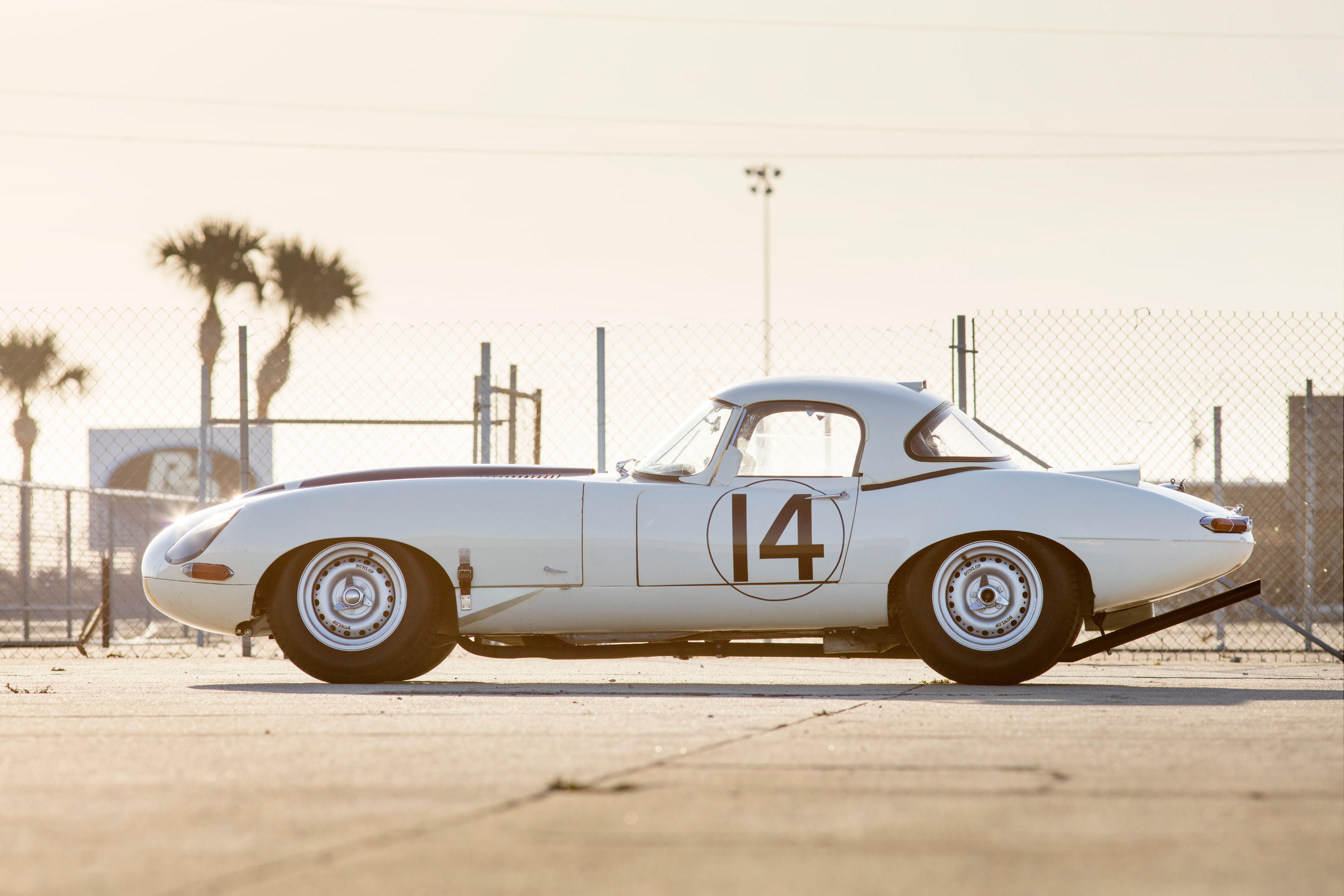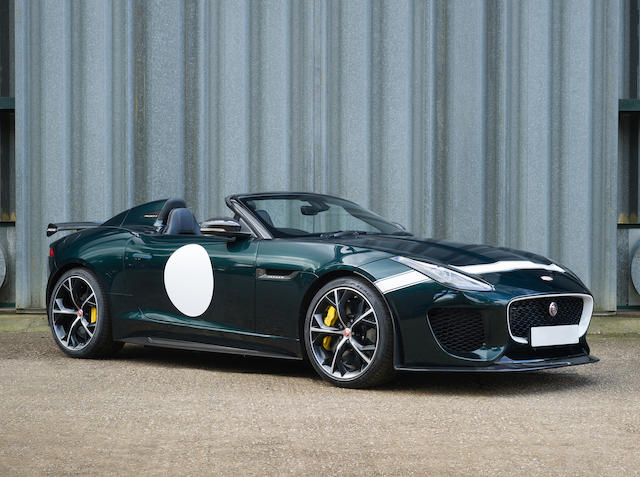Circa 1970 Jaguar D-Type ‘buck’ Lot Number236 Estimate£30,000 - £35,000 Print details Send this to a friend Contact us 4 more images Interested parties should note that contrary to our website and catalogue description this buck was made for Lynx Cars by Jensen Special Products in the early days of Lynx, probably post 1970, and is therefore not an original Buck from the 1950s as described. The Jaguar D-Type was produced by Jaguar Cars Ltd. between 1954 and 1957. Designed specifically to win the Le Mans 24-hour race, it shared the straight-six XK engine and many mechanical components with its C-Type predecessor. Its structure, however, was radically different, with innovative monocoque construction and slippery aerodynamics that integrated aviation technology, including in some examples a distinctive vertical stabiliser. Engine displacement began at 3.4 litres, it was enlarged to 3.8 litre in 1957 and reduced to 3.0 litre in 1958 when Le Mans rules limited engines for sports racing cars to that maximum. D-Types won Le Mans in 1955, 1956 and 1957. After Jaguar temporarily retired from racing as a factory team, the company offered the remaining unfinished D-Types as street-legal XKSS versions, whose perfunctory road-going equipment made them eligible for production sports car races in America. In 1957, 25 of these cars were in various stages of completion when a factory fire destroyed nine of them. Total production is thought by some to have totalled 71 D-Types, including 18 for factory teams and 53 for privateers (plus an additional 16 D-Types were converted into road-legal XKSS versions). Jaguar is quoted as claiming it built 75 D-Types The design applied aeronautical technology, revolutionary at the time. The ‘tub’, or cockpit section, was of monocoque construction, mostly comprising sheets of aluminium alloy. Its elliptical shape and comparatively small cross-section provided torsional rigidity and reduced drag. To the front bulkhead was attached an aluminium tubing subframe for the engine, steering assembly, and front suspension. Rear suspension and final drive were mounted to the rear bulkhead. Fuel was carried in the tail and the designers followed aviation practice by specifying a deformable Marston Aviation Division bag in place of a conventional tank. The aerodynamic influence was partly the work of Malcolm Sayer, who had joined Jaguar following a stint with the Bristol Aeroplane Company during the Second World War and later worked on the C-Type. The D-Type required a minimal frontal area. To reduce the XK engine's height dry sump lubrication was developed and it has been said that the car's frontal area was also a consideration in canting the engine at 8½ degrees from the vertical (which necessitated the offset bonnet bulge). Philip Porter, in his book Jaguar Sports Racing Cars, says that ‘a more likely reason was to provide extra space for the ram pipes feeding the three twin-choke Weber carburettors.’ Reducing underbody drag contributed to the car's high top speed; for the long Mulsanne Straight at Le Mans, a fin was mounted behind the driver for aerodynamic stability. For the 1955 season, factory cars were fitted with a longer nose, which lengthened the car by 7½ inches and further increased maximum speed; and the headrest fairing and aerodynamic fin were combined as a single unit that smoothed the aerodynamics and saved weight. This ‘buck’ was commissioned by Lynx engineering to create their own Long Nose D-Types and it was built by Jensen Special Products in the early days of Lynx, but probably post 1970. This is a great opportunity’ to purchase a very useable base to re create the famous Jaguar D-Type Long nose, as was carried out by Lynx Engineering to much success.
Circa 1970 Jaguar D-Type ‘buck’ Lot Number236 Estimate£30,000 - £35,000 Print details Send this to a friend Contact us 4 more images Interested parties should note that contrary to our website and catalogue description this buck was made for Lynx Cars by Jensen Special Products in the early days of Lynx, probably post 1970, and is therefore not an original Buck from the 1950s as described. The Jaguar D-Type was produced by Jaguar Cars Ltd. between 1954 and 1957. Designed specifically to win the Le Mans 24-hour race, it shared the straight-six XK engine and many mechanical components with its C-Type predecessor. Its structure, however, was radically different, with innovative monocoque construction and slippery aerodynamics that integrated aviation technology, including in some examples a distinctive vertical stabiliser. Engine displacement began at 3.4 litres, it was enlarged to 3.8 litre in 1957 and reduced to 3.0 litre in 1958 when Le Mans rules limited engines for sports racing cars to that maximum. D-Types won Le Mans in 1955, 1956 and 1957. After Jaguar temporarily retired from racing as a factory team, the company offered the remaining unfinished D-Types as street-legal XKSS versions, whose perfunctory road-going equipment made them eligible for production sports car races in America. In 1957, 25 of these cars were in various stages of completion when a factory fire destroyed nine of them. Total production is thought by some to have totalled 71 D-Types, including 18 for factory teams and 53 for privateers (plus an additional 16 D-Types were converted into road-legal XKSS versions). Jaguar is quoted as claiming it built 75 D-Types The design applied aeronautical technology, revolutionary at the time. The ‘tub’, or cockpit section, was of monocoque construction, mostly comprising sheets of aluminium alloy. Its elliptical shape and comparatively small cross-section provided torsional rigidity and reduced drag. To the front bulkhead was attached an aluminium tubing subframe for the engine, steering assembly, and front suspension. Rear suspension and final drive were mounted to the rear bulkhead. Fuel was carried in the tail and the designers followed aviation practice by specifying a deformable Marston Aviation Division bag in place of a conventional tank. The aerodynamic influence was partly the work of Malcolm Sayer, who had joined Jaguar following a stint with the Bristol Aeroplane Company during the Second World War and later worked on the C-Type. The D-Type required a minimal frontal area. To reduce the XK engine's height dry sump lubrication was developed and it has been said that the car's frontal area was also a consideration in canting the engine at 8½ degrees from the vertical (which necessitated the offset bonnet bulge). Philip Porter, in his book Jaguar Sports Racing Cars, says that ‘a more likely reason was to provide extra space for the ram pipes feeding the three twin-choke Weber carburettors.’ Reducing underbody drag contributed to the car's high top speed; for the long Mulsanne Straight at Le Mans, a fin was mounted behind the driver for aerodynamic stability. For the 1955 season, factory cars were fitted with a longer nose, which lengthened the car by 7½ inches and further increased maximum speed; and the headrest fairing and aerodynamic fin were combined as a single unit that smoothed the aerodynamics and saved weight. This ‘buck’ was commissioned by Lynx engineering to create their own Long Nose D-Types and it was built by Jensen Special Products in the early days of Lynx, but probably post 1970. This is a great opportunity’ to purchase a very useable base to re create the famous Jaguar D-Type Long nose, as was carried out by Lynx Engineering to much success.















Testen Sie LotSearch und seine Premium-Features 7 Tage - ohne Kosten!
Lassen Sie sich automatisch über neue Objekte in kommenden Auktionen benachrichtigen.
Suchauftrag anlegen